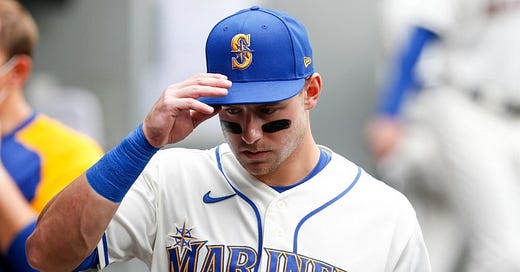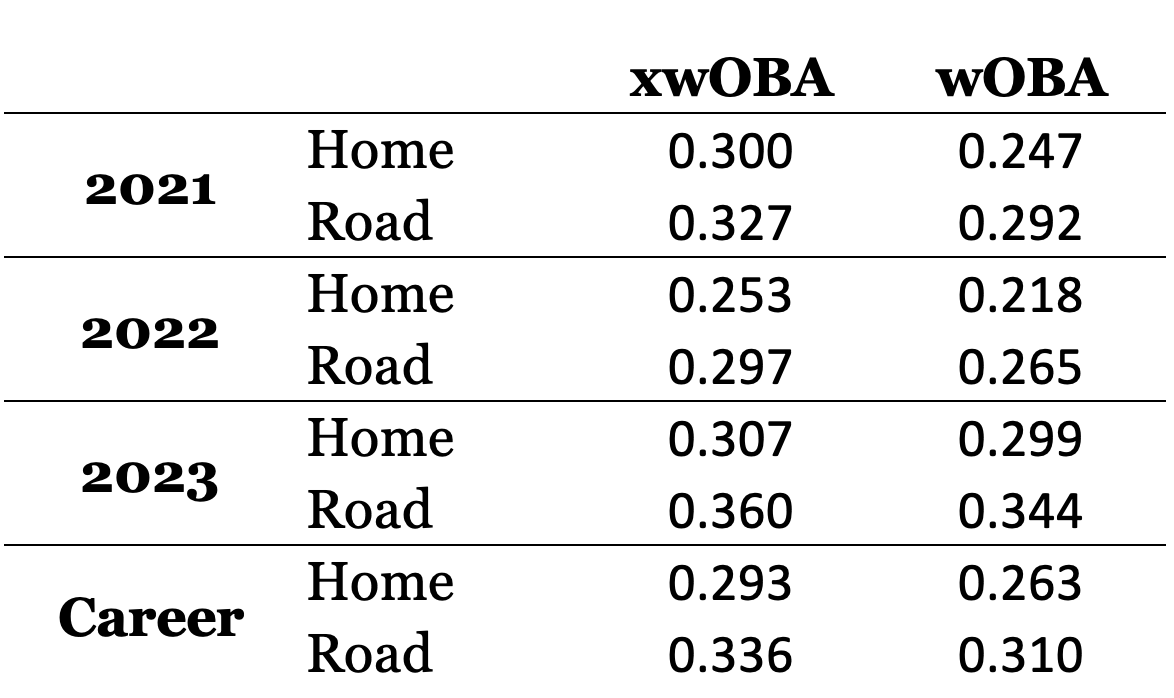The strange case of Dr. Home Kelenic and Mr. Road Kelenic
Kelenic might miss his Seattle friends, but he won’t miss T-Mobile Park.
Baseball has the weakest home field advantage of the major American sports, but the advantage is still real. There are various theories to explain the phenomenon, ranging from “umpires subconsciously favor the home team because nobody likes getting yelled at by 40,000 people” to “traveling sucks”.
Whichever one you favor, rip it up when it comes to Jarred Kelenic. Most players like home cooking? Kelenic subsists on expired Hot Pockets and locust-infested Rice-a-Roni. Most players like sleeping in their own beds? Kelenic lays down each night on splintered floorboards. Most players are energized by the roar of the home crowd? Kelenic finds it a demoralizing reminder of the dangers of a singleminded mob.
Enough talk. Here are the numbers.
Every year, Jarred Kelenic has had a home-road xwOBA split of at least 27 points and a home-road wOBA split reliably around 45 points.
Let’s start with the home-road wOBA split. This is normal and expected. The Mariners play in MLB’s most pitcher-friendly park. The dimensions and the marine layer at T-Mobile Park combine to depress offense. It would be weird if a hitter was putting up better baseball card numbers in Seattle than they were on the road. Simple enough.
The xwOBA splits are . . . less simple.
Kelenic’s xwOBA split is weird
It’s obvious why wOBA would depend on ballpark; a left-handed pull hitter will have a better wOBA in a ballpark with a short porch than in one with a cavernous right field, because wOBA distinguishes a 350-foot flyout to right from a 350-foot wall-scraper home run. But xwOBA doesn’t consider park dimensions - or even hit distance - at all. If you hit a baseball 107 mph off the bat at an 25-degree launch angle, that’s going to have the same xwOBA every time, no matter the outcome and no matter whether it goes 380 feet or 410 feet. So xwOBA theoretically shouldn’t vary that much from one park to another.
I wanted to see how much of an outlier Kelenic was, so I looked at every hitter who had at least 100 home PAs and 100 away PAs last year. I then calculated the difference between home xwOBA and away xwOBA for each player. Of the 353 players with sufficient PAs, Jarred Kelenic had the 19th highest home-road xwOBA deficit last year.
Here’s a chart to illustrate the same point. (You can explore this chart in full here.)
The highlighted dot here is Kelenic. His home xwOBA comparables: Alex Call, Tyrone Taylor, Nick Madrigal, and Tony Kemp. His road xwOBA comparables: Luis Robert Jr., Randy Arozarena, Bryan Reynolds, and Ozzie Albies. For some reason, Kelenic isn’t just benefiting from friendlier dimensions away from home; he’s simply a much better hitter outside of Seattle.
What’s causing the split?
I’ve been thinking about this for a few months, and with the help of a friend, I've come up with a few theories.
First, I thought, “Maybe this is weird but random.” Kelenic still hasn’t played that many games in his career, so maybe this is statistical noise. So I broke down Kelenic’s year-by-year performance into what he was doing when he put the ball in play (xwOBACON) and what he was doing when he didn’t (K%, BB%).
There’s no single answer. In 2021, Kelenic had virtually identical xwOBACONs at home and on the road, meaning his home-road xwOBA split was driven by his more favorable K-BB numbers on the road. In 2022, Kelenic had virtually identical K-BB numbers at home and the road, so this time, it was a massive gap in xwOBACON that made him a better road hitter. And in 2023, it was a little bit of both - a real xwOBACON advantage on the road, but also better strikeout and walk numbers.
So it’s not like the same component part is going wrong at home (or right on the road) in any given year. And that might be enough for me to say this is probably noise, except . . .
There might be something weird about T-Mobile Park. Go to the Tableau graph I made and search for other Mariners. Julio Rodríguez and JP Crawford both fall into the “good everywhere” group, though J-Rod is still 10 points better on the road. But José Caballero (.322 xwOBA on road/.272 xwOBA at home), Teoscar Hernández (.354/.315), and Cal Raleigh (.361/.296) are fellow Mariners with large road xwOBA advantages. Think about it - six Seattle hitters with 100 home and 100 away PAs, four are way better on the road, and none are significantly better at home. And of the four home underperformers, one (Raleigh) is a franchise cornerstone and the other three got picked up by three of the best-run organizations in baseball (Caballero is now a Ray and Hernández is now a Dodger).
Remember when I said that xwOBA generally won’t vary much from one park to another? There are exceptions. For example, xwOBAs are higher at Coors Field, because the thin air adversely affects breaking balls, which means hitters can make better contact. Ask Charlie Blackmon and his .322 road xwOBA/.351 home xwOBA last year. So maybe there’s something about T-Mobile Park that makes it the inverse Coors. Perhaps the shadows fall over home plate in a way that makes it harder to track the ball. Perhaps the stadium has an odd batter’s eye. Since 2019, T-Mobile Park has the second lowest average xwOBA of any venue in the sport. Sure, some of that is attributable to the home team’s tepid lineups. But combine that information with the home-road splits from above, and it’s at least intriguing.
What does it this all mean?
The best case scenario is that Jarred Kelenic enjoys the Willy Adames Effect. As a Tampa Bay Ray, Adames put up excellent batted-ball numbers on the road and horrid numbers at Tropicana Field. Later asked about it, Adames said:
“Whenever I was out of the Trop, I feel like I was able to recognize the spin of the ball. You could see if it was a breaking ball, changeup or whatever. At The Trop, I couldn’t pick it up.”
And sure enough, as soon as Adames didn’t have to play half his games at a stadium where he couldn’t see the ball well, he became one of the best offensive shortstops in the sport.
Jarred Kelenic was fine on the road in 2021 and awful everywhere in a short 2022 sample, but he was a great road hitter in 2023 - by far his longest (and, of course, most recent) campaign. A fun way of thinking about it: if you remove all games played at T-Mobile Park last year, Kelenic was a top 50 hitter in the sport (min. 200 PA), ahead of Michael Harris II, Luis Arraez, Corbin Carroll, Luis Robert Jr., and even teammate Julio Rodríguez. Obviously, you can’t just pretend the games didn’t happen. But say that Kelenic’s road numbers are more representative of who he’ll be moving forward. Then you’re talking about a really good hitter, even with the elevated K rate. You’re talking about a hitter who would’ve put up a top-25 xwOBACON in baseball last year, good for third on the most powerful offense in recent baseball history, and then thrown in an above-average walk rate for fun.
We won’t know anything for sure till the games start and the data starts piling up. But at the very least, when Jarred Kelenic hops into his car and sees Truist Park appear in the horizon on I-285 when the home opener rolls around, he won’t be filled with the dread that must come from playing in an offensive hell.
*This newsletter is free. Please consider donating to Equal Justice Initiative if you enjoyed it.*








